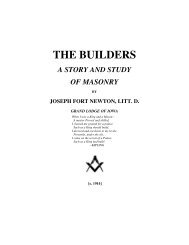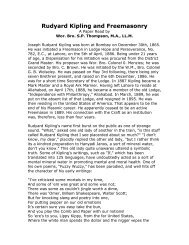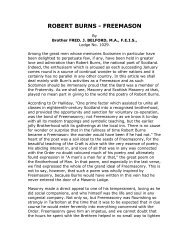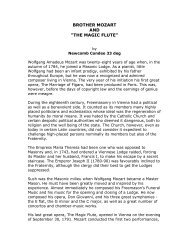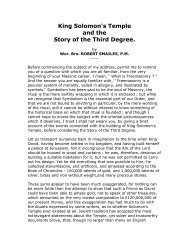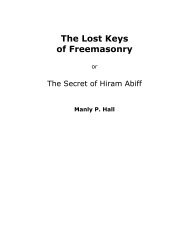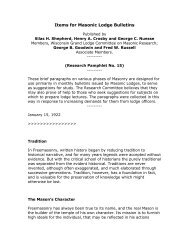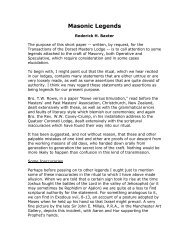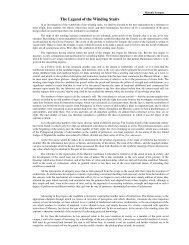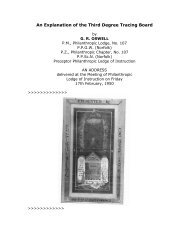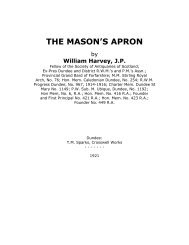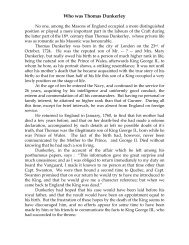- Page 1 and 2:
DUNCAN'S Masonic Ritual and Monitor
- Page 3 and 4:
The author of the following work do
- Page 5 and 6:
LODGE OF ENTERED APPRENTICES, FELLO
- Page 7 and 8:
J. D.--Worshipful Master, there is
- Page 9 and 10:
their stations as represented in Pl
- Page 11 and 12:
W. M.--The Senior Deacon's place in
- Page 13 and 14:
FIG. 1. DUEGARD OF AN ENTERED APPRE
- Page 15 and 16:
FIG. 6. SIGN OF A MASTER MASON. FIG
- Page 17 and 18:
COMPASSES, PLACED IN A LODGE OF ENT
- Page 19 and 20:
A regular communication of St. John
- Page 21 and 22:
SOLOMON NORTHUS, W. M. Such is the
- Page 23 and 24:
W. M.--Is the chairman of the commi
- Page 25 and 26:
also say to Mr. Gabe, that as soon
- Page 27 and 28:
The candidate is now requested to s
- Page 29 and 30:
W. M.--Let no one enter on so impor
- Page 31 and 32:
p. 32 J. W.--Of lawful age, and pro
- Page 33 and 34:
(left to right: Master. Altar. Cand
- Page 35 and 36:
token of my brotherly love and favo
- Page 37 and 38:
p. 38 J. W.--Give me a sign. Senior
- Page 39 and 40:
the east. As they leave the west, a
- Page 41 and 42:
for the builder's use; but we, as F
- Page 43 and 44:
Q. B. A. O. p. 43 Q. Z. A. Bo. Q. A
- Page 45 and 46:
Q. How did the Junior Warden dispos
- Page 47 and 48:
not from its intrinsic valuation, b
- Page 49 and 50:
and the heart and tongue join in pr
- Page 51 and 52:
Q. Why were you caused to meet with
- Page 53 and 54:
Q. Why are they said to represent t
- Page 55 and 56:
Q. What do they masonically teach u
- Page 57 and 58:
Prudence teaches us to regulate our
- Page 59 and 60:
cemented by sincere attachment, hyp
- Page 61 and 62:
Order. It is unwise to assert more
- Page 63 and 64:
all the ceremonies peculiar to this
- Page 65 and 66:
J. D.--Then you will take off your
- Page 67 and 68:
two Stewards, when the Senior Deaco
- Page 69 and 70:
W. M.--Has he made suitable profici
- Page 71 and 72:
FIG. 10. CANDIDATE TAKING THE OATH
- Page 73 and 74:
W. M.--In your present condition, w
- Page 75 and 76:
W. M.--Halve it, and begin. Conduct
- Page 77 and 78:
J. W.--Has it a name? Conductor--It
- Page 79 and 80:
W. M.--The plumb is an instrument m
- Page 81 and 82:
Brother, the first thing that parti
- Page 83 and 84:
J. W.--How do you expect to gain ad
- Page 85 and 86:
W. M.--Brother Gabe, you have now a
- Page 87 and 88:
with the most useful knowledge: whi
- Page 89 and 90:
Q. How were you then disposed of? A
- Page 91 and 92:
Q. Where did they work? A. At the b
- Page 93 and 94:
Q. Who cast them? p. 84 A. Our Gran
- Page 95 and 96:
Q. How did the Senior Warden dispos
- Page 97 and 98:
76:1 Shibboleth signifies waters. T
- Page 99 and 100:
ethren acting as such. PREPARING TH
- Page 101 and 102:
Junior Deacon here steps forward an
- Page 103 and 104:
Our Great Creator, and his Truth, E
- Page 105 and 106:
your left in the hollow of your rig
- Page 107 and 108:
hereon most solemnly and sincerely
- Page 109 and 110:
W. M.--From what and to what? p. 97
- Page 111 and 112:
J. W.--Will you give it me? Conduct
- Page 113 and 114:
Warden takes from his desk a small
- Page 115 and 116:
secrets of this Degree. You have a
- Page 117 and 118:
p. 104 Ruffian--This (shaking candi
- Page 119 and 120:
Conductor--I will not! Ruffian--The
- Page 121 and 122:
First Ruffian--Well, we have all me
- Page 123 and 124:
They shuffle about a few moments, w
- Page 125 and 126:
Second Craftsman--The very fellows
- Page 127 and 128:
caught hold of a sprig of acacia, 1
- Page 129 and 130:
They then commence to search about
- Page 131 and 132:
"Solemn strikes the funeral chime,
- Page 133 and 134:
p. 120 BRETHREN KNEELING AT PRAYER
- Page 135 and 136:
FIG 18. MASTER GIVING THE GRAND MAS
- Page 137 and 138:
word, and, on his like refusal, gav
- Page 139 and 140:
p. 125 Lodges, until future generat
- Page 141 and 142:
. GROUND FLOOR . MIDDLE CHAMBER THE
- Page 143 and 144:
AND ARK Are emblems of a well-groun
- Page 145 and 146:
p. 131 . SETTING-MAUL COFFIN, GRAVE
- Page 147 and 148:
W. M.--Brother Gabe, in closing thi
- Page 149 and 150:
A. Brother A. B., who has been regu
- Page 151 and 152:
Q. After being taught to wear your
- Page 153 and 154: A. They buried it in the rubbish of
- Page 155 and 156: A. Three grand columns or pillars.
- Page 157 and 158: W. M.--Any thing in the south, Brot
- Page 159 and 160: S. D.--At the left hand of the Wors
- Page 161 and 162: CHARGE AT CLOSING A LODGE BRETHREN:
- Page 163 and 164: Footnotes 87:1 Our present Third De
- Page 165 and 166: (Jubelum)." But we must look a litt
- Page 167 and 168: S. (Sanctum Santorum) in case sudde
- Page 169 and 170: p. 150 MARK MASTER, OR FOURTH DEGRE
- Page 171 and 172: The door is tyled, Right Worshipful
- Page 173 and 174: J. G. W.--As the sun is in the sout
- Page 175 and 176: Here the Right Worshipful Master gi
- Page 177 and 178: maliciousness, but as the servants
- Page 179 and 180: Junior Overseer--Have you a specime
- Page 181 and 182: p. 161 you assemble the craft, and
- Page 183 and 184: R. W. M. (to Senior Deacon.)--It is
- Page 185 and 186: The door is then opened--the candid
- Page 187 and 188: As soon as the candidate has taken
- Page 189 and 190: Arise, brother, and I will invest y
- Page 191 and 192: Right Worshipful Master strikes the
- Page 193 and 194: TOOLS OF A MARK MASTER. God and man
- Page 195 and 196: At this information, all the brethr
- Page 197 and 198: Q. Among so large a number was not
- Page 199 and 200: A. He directed me to be conducted t
- Page 201 and 202: A. To the rejection of the "Key Sto
- Page 203: Q. What is that new name? A. It is
- Page 207 and 208: p. 184 PAST MASTER, OR FIFTH DEGREE
- Page 209 and 210: for himself; and unless he is willi
- Page 211 and 212: 15. You agree that no visitors shal
- Page 213 and 214: Furthermore do I promise and swear,
- Page 215 and 216: All the brethren present, headed by
- Page 217 and 218: invited into a Lodge of Mark Master
- Page 219 and 220: LECTURE ON THE FIFTH, OR PAST MASTE
- Page 221 and 222: Q. What were you next presented wit
- Page 223 and 224: the Society over which he is to pre
- Page 225 and 226: Master (to the Senior Warden.)--Bro
- Page 227 and 228: The Senior Warden repeats this to h
- Page 229 and 230: Senior Deacon whispers in his ear t
- Page 231 and 232: Furthermore do I promise and swear,
- Page 233 and 234: All hail to the morning that bids u
- Page 235 and 236: FIG. 30. SIGN OF ADMIRATION, OR AST
- Page 237 and 238: Answer. I am. Try me. Q. How will y
- Page 239 and 240: A. I will with your assistance. Q.
- Page 241 and 242: instrumental, praising Jehovah upon
- Page 243 and 244: who continued the ceremonies only o
- Page 245 and 246: High Priest--Companion Captain, the
- Page 247 and 248: High Priest--The King's station and
- Page 249 and 250: left-hand companion, and his left h
- Page 251 and 252: Je ho vah. G o d. d G G o o d. 1 Af
- Page 253 and 254: Captain--It is our Most Excellent H
- Page 255 and 256:
I furthermore promise and swear, th
- Page 257 and 258:
'Zedekiah was one-and-twenty years
- Page 259 and 260:
The candidates, after passing the L
- Page 261 and 262:
FIG. 33. SIGN OF THE MASTER OF THE
- Page 263 and 264:
as snow. My word of exhortation is
- Page 265 and 266:
"In that day will I take thee, O Ze
- Page 267 and 268:
WORKING TOOLS OF A ROYAL ARCH MASON
- Page 269 and 270:
things? For they shall rejoice, and
- Page 271 and 272:
p. 245 EMBLEMS OF THE ROYAL ARCH DE
- Page 273 and 274:
Looking again into the Ark, the Hig
- Page 275 and 276:
forming a triangle, three left hand
- Page 277 and 278:
p. 253 So we three do agree To clos
- Page 279 and 280:
A. Blue, purple, scarlet and white.
- Page 281 and 282:
Q. Give the pass? A. Rabboni. Q. Wh
- Page 283 and 284:
A. Seventy (70) years. Q. By whom w
- Page 285 and 286:
Q. Where did you meet with the next
- Page 287 and 288:
Q. Your answer? A. Three worthy soj
- Page 289 and 290:
A. That the task would be attended
- Page 291 and 292:
A. To the way and manner in which m
- Page 293 and 294:
2. BAAL OR BEL. This word signifies
- Page 295 and 296:
The Insignia of the Royal Arch, p.
- Page 297 and 298:
your own eyes, if, indeed, you are
- Page 299 and 300:
LANDMARKS.--What are the landmarks?
- Page 301 and 302:
the sides. Clambering down it, I fo
- Page 303 and 304:
successors until the reign of Cyrus
- Page 305 and 306:
Q. What did they do with the body?
- Page 307 and 308:
Q. What supported the temple? A. It
- Page 309 and 310:
p. 278 lectures he received from We
- Page 311 and 312:
underwent some modifications (which



